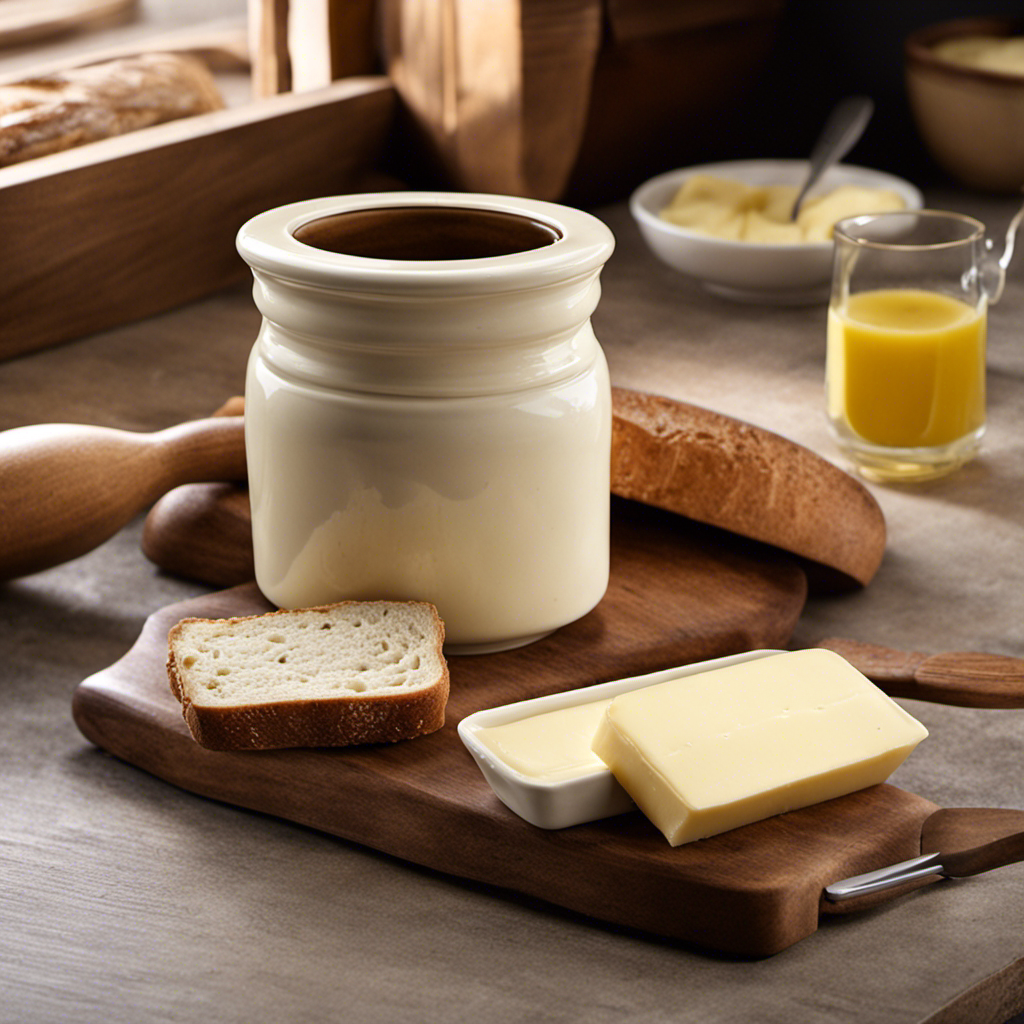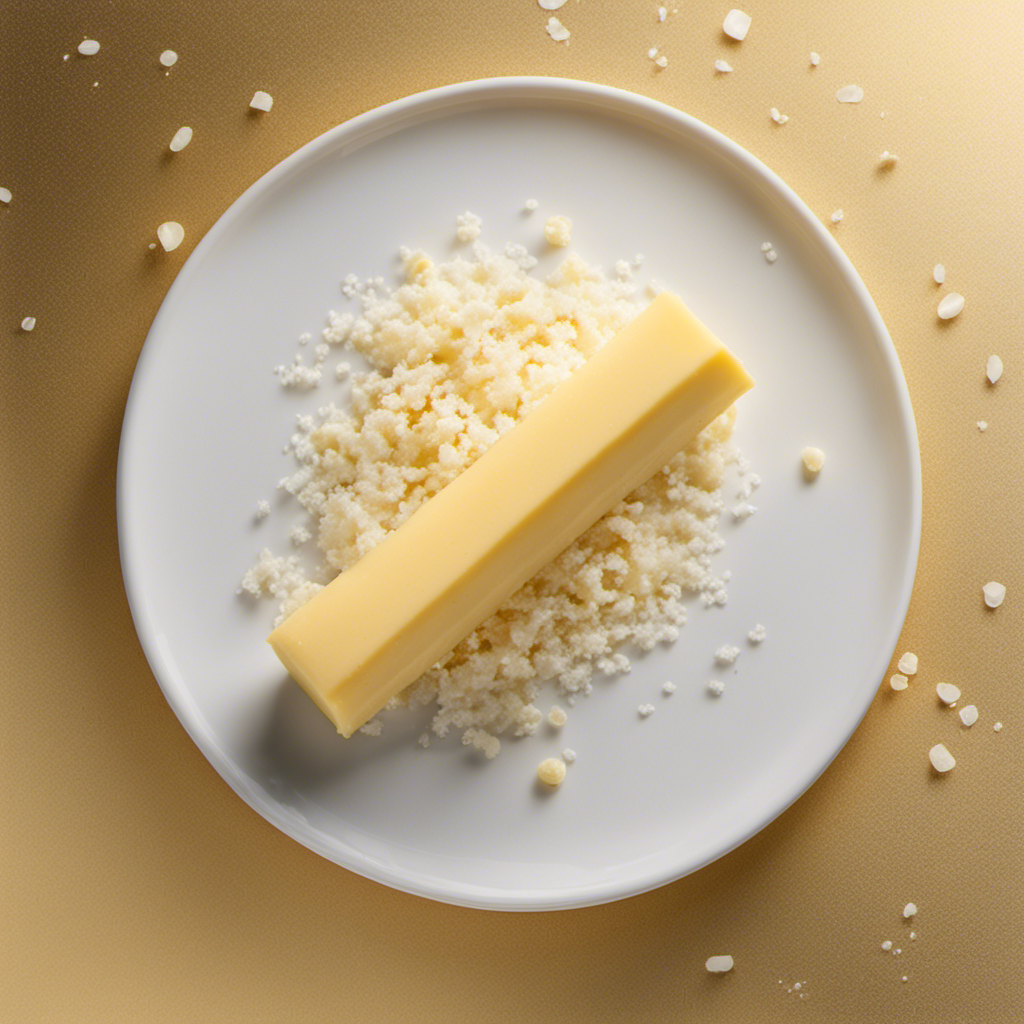Did you know that the average American consumes approximately 5.6 pounds of butter each year? For those of us who love butter, it is important to know how to keep it fresh and easy to spread.
That’s where a butter keeper comes in. In this article, I’ll guide you through the process of using a butter keeper to maintain the perfect texture and flavor of your butter.
From choosing the right keeper to maximizing its shelf life, get ready to elevate your butter game to a whole new level.
Key Takeaways
- Choose a butter keeper that suits your needs in terms of size and design.
- Opt for a material that is easy to clean and durable, such as ceramic, glass, or plastic.
- Soften the butter at room temperature before storing and cut it into small slices or cubes for easier access.
- Select a butter keeper with an airtight lid to prevent the butter from absorbing odors and to maintain its freshness.
Choosing the Right Butter Keeper
To choose the right butter keeper, consider the size and design that suits your needs. When it comes to maintenance, choose a material that is easy to clean and durable. Common materials include ceramic, glass, and plastic.
Ceramic butter keepers have a classic look and keep butter fresh for longer. Glass keepers allow you to easily see the amount of butter left and are dishwasher safe. Plastic keepers are lightweight and often have airtight lids for better preservation.
Ultimately, the choice of material depends on your preferences and maintenance commitment.
Now, let’s move on to preparing your butter for storage.
Preparing Your Butter for Storage
Before placing it in the keeper, make sure your butter is at room temperature for easy storage.
To properly store butter, follow these steps:
- Allow the butter to soften at room temperature before storing.
- Cut the butter into small slices or cubes for easier access later.
- Choose a container that is airtight to prevent the butter from absorbing odors from the fridge.
- Consider using a butter keeper, specifically designed to keep butter fresh and spreadable.
Properly storing butter is crucial to maintain its freshness and flavor. By choosing the right container and following these steps, you can ensure that your butter stays in perfect condition.
Now that your butter is ready, let’s move on to the next step of placing it in the butter keeper.
Placing Butter in the Butter Keeper
Now that you’ve softened your butter, it’s time to put it in the airtight container.
Choosing the right butter dish is crucial for keeping your butter fresh and spreadable. Look for a dish that is large enough to hold a stick or two of butter, with a lid that creates a tight seal. This will prevent any air from getting in and spoiling your butter.
Place the softened butter in the dish, making sure to spread it evenly.
If you encounter any issues with your butter keeper, such as the butter becoming too hard or too soft, try adjusting the temperature of your refrigerator. If that doesn’t work, you may need to experiment with different butter keepers until you find one that suits your needs.
Understanding the Importance of Temperature Control
When adjusting the temperature of your refrigerator, make sure to find the right setting to keep your butter at the ideal consistency. Proper temperature control is crucial for maintaining the freshness and quality of your butter. Here are a few reasons why temperature control is important:
-
Preserves Flavor: The right temperature prevents the butter from absorbing strong odors and flavors in the fridge, ensuring that it retains its own delicious taste.
-
Prevents Spoilage: Maintaining a cool temperature inhibits the growth of bacteria, mold, and yeast, extending the shelf life of your butter.
-
Maintains Texture: Consistent temperature control prevents the butter from becoming too soft or too hard, allowing it to spread easily and evenly.
-
Enhances Food Safety: By storing butter at the proper temperature, you reduce the risk of foodborne illnesses caused by bacteria growth.
Understanding the importance of temperature control is vital for ensuring that your butter remains fresh and delicious. Now, let’s move on to the next section and explore how to maintain the butter keeper.
Maintaining the Butter Keeper
To properly maintain your butter keeper, it’s important to regularly clean and dry it to prevent any bacteria or mold growth. Mold prevention is crucial because it can spoil your butter and make it unsafe to consume.
After each use, wash the butter keeper with warm soapy water, making sure to remove any residue or crumbs. Rinse it thoroughly and dry it completely before adding fresh butter. This will help to eliminate any moisture that could contribute to mold growth.
Additionally, it’s essential to keep your butter keeper at a consistent temperature to ensure the butter stays fresh and spreadable. Avoid placing it near direct sunlight or heat sources, as this can cause the butter to melt or spoil.
Cleaning and Caring for Your Butter Keeper
To keep your butter keeper clean and well-maintained, regularly wash and dry it to prevent bacteria or mold growth. Cleaning methods may vary depending on the material of your butter keeper, but here are some general steps to follow:
- Use warm water and a gentle dish soap to clean the butter keeper.
- Avoid using abrasive materials or harsh chemicals that could damage the surface.
- Rinse thoroughly to remove any soap residue.
- Dry the butter keeper completely before adding fresh butter.
Choosing the right size butter keeper is also important. Consider the amount of butter you typically use and the space available in your refrigerator. A smaller butter keeper may be suitable for individuals or small households, while a larger one may be necessary for families or those who use butter frequently.
Troubleshooting Common Butter Keeper Issues
When it comes to using a butter keeper, there are a few common issues that can arise. One of the main concerns is preventing mold and bacteria from growing on the butter.
Another problem that may occur is when the butter becomes too soft, making it difficult to spread. On the other hand, there are also times when the butter can become too hard, making it challenging to use.
In this discussion, we will explore these key points and provide helpful tips and solutions to troubleshoot these common butter keeper issues.
Mold and Bacteria Prevention
Make sure you’re regularly cleaning your butter keeper to prevent mold and bacteria from growing. Neglecting proper maintenance can result in cross contamination and spoilage of your butter. Here are some key steps to keep your butter keeper clean and free from harmful microorganisms:
- Wash the butter keeper with warm soapy water after each use.
- Use a soft brush or sponge to remove any residue or buildup.
- Dry the butter keeper thoroughly before adding fresh butter.
- Store the butter keeper in a cool and dry place to inhibit the growth of mold and bacteria.
By following these simple maintenance tips, you can ensure that your butter stays fresh and safe for consumption.
Don’t let mold and bacteria ruin your buttery goodness; take care of your butter keeper and enjoy delicious, uncontaminated butter every time.
Butter Too Soft
Now, let’s talk about what to do when your butter becomes too soft.
We all know that butter has a limited shelf life, and sometimes it can become too soft, making it difficult to spread or use in recipes. But fear not, because a butter keeper can come to the rescue!
When your butter is too soft, simply place it in the butter keeper and store it in the refrigerator. The butter keeper will help maintain a cool temperature, preventing the butter from melting or becoming overly soft. This way, your butter will stay fresh for longer, and when you’re ready to use it, it will be perfectly softened and ready to spread.
But what if your butter is too hard? Let’s find out in the next section.
Butter Too Hard
Don’t worry if your butter is too hard – there’s a simple solution for that too. When your butter is too hard to spread, it can be frustrating. But with a little trick, you can easily soften it to the perfect consistency.
Here’s what you can do:
- Take a microwave-safe dish and place the hard butter in it.
- Heat the butter in the microwave for a few seconds at a time, checking its consistency in between.
Alternatively, you can grate the hard butter using a cheese grater to make it easier to spread. Another option is to place the butter in a sealed plastic bag and submerge it in warm water until it softens.
These methods will help you soften your butter quickly and effortlessly. Remember, proper butter storage is also essential to prevent it from becoming too hard. Keep your butter in a butter keeper or a covered dish at room temperature for easy spreading.
Using the Butter Keeper for Different Types of Butter
When it comes to using a butter keeper for different types of butter, there are a few key points to consider.
First, the debate between salted and unsalted butter is important to address.
Second, achieving the perfect spreadable consistency is a goal for many butter lovers.
And finally, storing flavored butter requires some extra thought and care.
Let’s dive into these topics and explore how the butter keeper can help us make the most of our butter experience.
Salted Vs. Unsalted
It’s important to consider whether you prefer salted or unsalted butter when using a butter keeper. The type of butter you choose will affect its taste and versatility in cooking. Here are some key points to consider:
-
Salted butter: This type of butter contains added salt, which enhances its flavor and extends its shelf life. It’s great for spreading on bread or toast, and adds a savory element to baked goods and savory dishes.
-
Unsalted butter: Also known as sweet butter, this type of butter is pure and without any added salt. It provides a neutral taste, allowing the flavors of other ingredients to shine. It’s ideal for baking, as it gives you more control over the saltiness of your recipes.
-
Personal preference: Your choice between salted and unsalted butter will depend on your taste preferences and the recipes you plan to make. Some people like the convenience and flavor of salted butter, while others prefer the flexibility and control of unsalted butter.
Considering whether you prefer salted or unsalted butter will help you make the most of your butter keeper. Now let’s explore how to achieve the perfect spreadable consistency.
Spreadable Consistency
To achieve the perfect spreadable consistency, you’ll want to take your butter out of the refrigerator and let it sit at room temperature for a while. This process is called softening the butter, and it makes it easier to spread on bread, toast, or any other delicious treat.
When butter is cold, it tends to be hard and unmalleable, making it difficult to spread smoothly. But by allowing it to warm up to room temperature, the butter becomes soft and creamy, making it a breeze to spread.
It’s important to note that softening butter should be done gradually, as leaving it out for too long can cause it to become too soft or even melt. So, next time you’re craving some spreadable butter, remember to give it some time to soften before digging in.
Storing Flavored Butter
After learning about the spreadable consistency of butter, let’s explore the exciting world of flavored butter recipes and creative butter storage ideas. Flavored butter is a delightful way to elevate your dishes with a burst of taste. From savory garlic and herb butter to sweet honey cinnamon butter, the possibilities are endless.
To ensure your flavored butter stays fresh and ready to use, here are some creative storage ideas:
-
Butter crock: This traditional method involves placing the butter in a small ceramic crock, filling the bottom with water, and sealing it with a lid. The water creates an airtight seal, keeping the butter fresh and spreadable.
-
Butter bell: Similar to a butter crock, a butter bell uses water to create an airtight seal. The butter is placed in a bell-shaped container that sits upside down in a water-filled base.
-
Butter molds: These decorative molds allow you to shape your butter into unique designs, making it both functional and visually appealing.
-
Butter papers: Wrapping your flavored butter in parchment or wax paper not only keeps it fresh but also adds a charming touch when presenting it to guests.
With these flavorful butter recipes and creative storage ideas, you’ll be ready to add a delicious twist to your meals while keeping your butter fresh and accessible.
Maximizing the Shelf Life of Your Butter
If you want to maximize the shelf life of your butter, make sure to store it in a butter keeper. A butter keeper is a simple yet ingenious device that helps in maximizing butter freshness and preventing butter spoilage.
It consists of a base and a lid, with the base holding water that creates an airtight seal when the lid is placed on top. By keeping the butter submerged in water, the butter keeper creates an environment that prevents air and bacteria from reaching the butter, thus extending its shelf life.
Not only does it keep the butter fresh, but it also makes it spreadable and ready to use at all times.
Now that you know why using a butter keeper is important, let’s dive into some tips and tricks for using one effectively.
Tips and Tricks for Using a Butter Keeper
One helpful tip for effectively using a butter keeper is to regularly change the water to maintain freshness. By keeping the water fresh, you can ensure that your butter stays in optimal condition for longer periods of time.
Here are some additional tips and tricks for using a butter keeper:
- Keep the butter keeper in a cool and dry place to prevent the butter from melting or becoming rancid.
- Use a clean utensil to transfer the butter into the keeper, avoiding any contamination.
- Seal the butter keeper tightly to prevent air from entering and spoiling the butter.
- Consider using unsalted butter in the butter keeper, as salted butter can spoil faster.
By following these butter storage techniques, you can enjoy fresh and spreadable butter whenever you need it.
Now, let’s explore alternative uses for your butter keeper.
Exploring Alternative Uses for Your Butter Keeper
To get creative with your butter keeper, try repurposing it as a small storage container for spices or herbs.
One of the alternative uses for a butter keeper is to use it as a convenient and stylish way to store your favorite spices or herbs.
The airtight seal of the butter keeper will help keep your spices fresh and flavorful for longer periods of time.
Simply fill the butter keeper with your desired spice or herb, seal it tightly, and place it in your pantry or kitchen countertop.
Not only will this save space in your kitchen, but it will also add a unique and decorative touch to your spice collection.
Frequently Asked Questions
Can I Use Any Type of Butter in a Butter Keeper?
Yes, you can use any type of butter in a butter keeper. It’s designed to keep butter soft and spreadable, so it works with salted, unsalted, and even flavored butters. However, there are alternative methods for keeping butter fresh and spreadable.
How Long Can Butter Be Stored in a Butter Keeper?
Butter can be stored in a butter keeper for about a week. The shelf life depends on the temperature and proper storage. By keeping it in a butter keeper, you can maintain its freshness and spreadability.
Can I Leave My Butter Keeper Out on the Countertop?
Leaving a butter keeper out on the countertop has its pros and cons. It keeps the butter soft and spreadable, but it can also lead to spoilage. To properly clean and maintain a butter keeper, rinse it with warm water and mild soap.
Can I Use a Butter Keeper for Margarine or Other Spreads?
Yes, you can use a butter keeper for alternative spreads like margarine. It helps keep them fresh and spreadable. The benefits of using a butter keeper include convenience, easy access, and maintaining the perfect consistency for your spreads.
Can I Store Flavored Butter in a Butter Keeper?
Yes, you can store flavored butter in a butter keeper. It’s a great way to keep the flavors intact and spreadable. As for alternatives, you can also use other spreads like margarine.
Conclusion
In conclusion, using a butter keeper is a game changer for butter lovers like me. It not only keeps my butter fresh and spreadable, but also adds a touch of elegance to my kitchen countertop.
As I open the lid and see the creamy goodness inside, it’s like a ray of golden sunshine illuminating my breakfast routine.
With the right temperature control and proper maintenance, my butter stays delicious for longer, giving me endless possibilities to enjoy it in various recipes.
So, why not indulge in the buttery goodness and make your mornings a little more delightful with a butter keeper?










